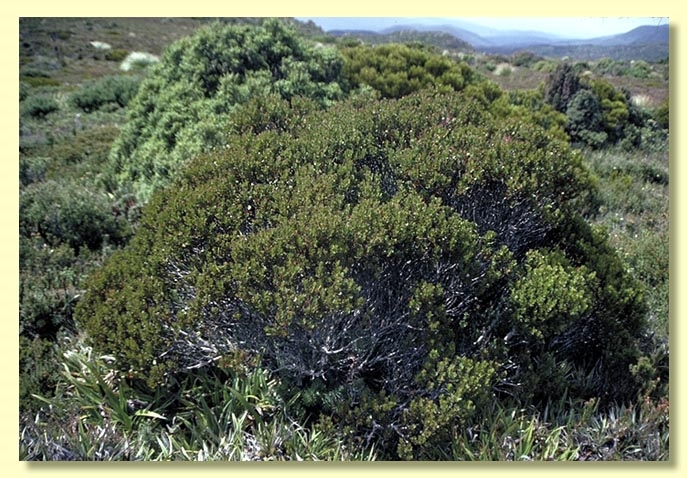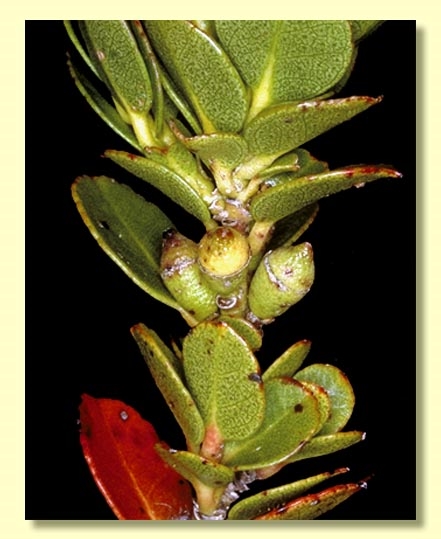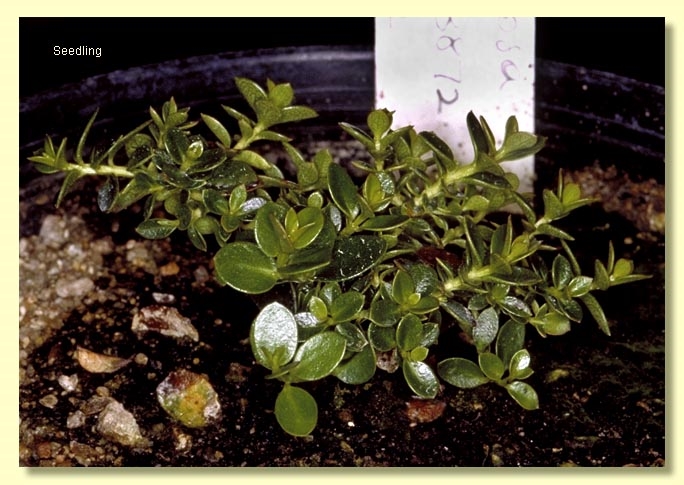Euclid - Online edition
Eucalyptus vernicosa
Eucalyptus | Symphyomyrtus | Maidenaria | Euryotae | Semiunicolores
T: Mt Fatigue, Tas., 4 Apr. 1842, R.Gunn 1113; holo: K.
Bark smooth grey or grey-brown.
Juvenile growth (coppice or field seedlings to 50 cm): stems square in cross-section but difficult to see due to crowding of the juvenile leaves which are opposite, sessile or subsessile, ovate, 0.7–2 cm long, 0.3–1.5 cm wide, with truncate or rounded base and subcrenulate to entire margin, slightly discolorous, glossy, green.
Adult leaves crowded, opposite or alternate, petiole 0.1–0.8 cm long; blade orbicular to ovate or elliptical, 1–3.2 cm long, 0.8–1.5(2.2) cm wide, base tapering to petiole or rounded, margin entire or subcrenulate, concolorous or slightly discolorous, glossy, green, side-veins greater than 45° to midrib, moderately to densely reticulate, intramarginal vein parallel to and just within margin or well removed from it, oil glands island.
Inflorescence axillary unbranched, peduncles 0–0.2(1.0) cm long, buds 1 or 3 per umbel, (one-budded by abortion), sessile or subsessile. Mature buds ovoid to obovoid, 0.8–0.9 cm long, 0.3–0.5 cm wide, green to yellow-brown, often slightly angled longitudinally, scar present, operculum conical, stamens inflexed or irregularly flexed, anthers cuboid to oblong, versatile, dorsifixed, dehiscing by longitudinal slits (non-confluent), style long, stigma blunt, locules 3 or 4, the placentae each with 4 vertical ovule rows. Flowers white.
Fruit sessile or subsessile, hemispherical or campanulate, 0.5–0.8 cm long, 0.5–0.9 cm wide, often slightly angled longitudinally, disc descending, valves 3 or 4, near rim level.
Seeds brown or black, 1–2 mm long, ovoid or flattened-ovoid, dorsal surface shallowly pitted, hilum ventral.
Cultivated seedlings (measured at ca node 10): cotyledons bilobed; stems square in cross-section; leaves opposite, sessile, ovate to elliptic, 0.7–2.3 cm long, 0.3–1.5 cm wide, base more or less rounded or slightly lobed (not amplexicaul), margin entire or subcrenulate, apex pointed, slightly discolorous, glossy green above, paler beneath.
Flowering has been recorded in January, February, March, April, May, June, September, October, November and December with peak flowering in January, February and December (see Williams & Potts, 1996, p. 119).
A small shrub often over 1 m tall or, more rarely, a small stunted tree; endemic to Tasmania, where it is confined to mountains and high plateaus in southern and western areas, on exposed or poorly drained sites. Some lower altitude records are known towards the west coast.
Eucalyptus vernicosa is easily recognised by the habit, usually opposite, very shortly petiolate, small, glossy, green leaves to 3 cm long, peduncles absent or to 0.2 cm long, and more or less sessile buds and fruit formed in threes though often appearing solitary due to abortion.
Eucalyptus vernicosa belongs in Eucalyptus subgenus Symphyomyrtus section Maidenaria, a large group of species more or less restricted to south-eastern Australia, characterised by bilobed cotyledons, simple axillary inflorescences, buds with two opercula, stamens with versatile anthers and flattened seeds with a ventral hilum. Within this section, E. vernicosa, with four other species, forms series Semiunicolores, having smooth bark, crowded, subcrenulate and strongly glandular juvenile leaves opposite for many nodes which, in this species, persist to form the leafy crown, buds in threes, and more or less sessile fruit. Three of the species in this series are closely related Tasmanian endemics, viz. E. johnstonii, E. subcrenulata, both trees, and E. vernicosa.
Eucalyptus vernicosa and E. subcrenulata form a morphological continuum where their ranges meet. The remaining two species in series Semiunicolores, E. imlayensis and E. elaeophloia, are high altitude localised endemics in southern New South Wales and Victoria respectively and have more greyish green juvenile leaves.










